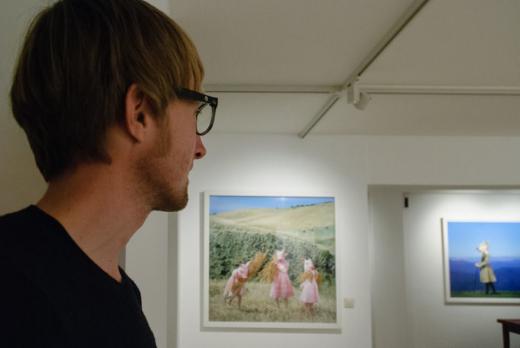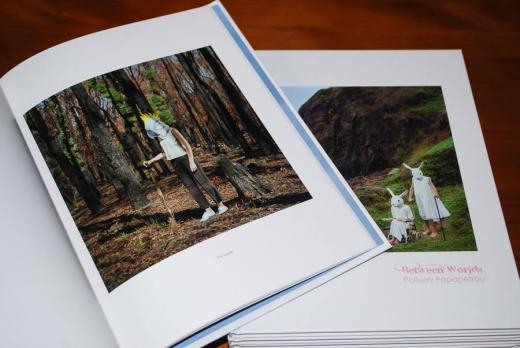Have You Met... Michael Dooney
Have You Met... Michael Dooney
Last week, a new gallery opened in Berlin with the inaugural exhibition, "Between Worlds", by Polixeni Papapetrou. The gallery focuses on Australian and New Zealand photography, and serves as a stepping stone to wider recognition for the artists from the area, as well as a window into the art production of the two distant lands. I spoke to the director Michael Dooney to find out more about this new pin on the Mitte gallery map.
How did you come up with the idea of opening this gallery?
I often go to exhibitions and photography is what I am drawn to. Also, I feel there is a genuine curiosity in Germany for people from Australia and New Zealand, because we are from such a faraway place. While visiting an opening at the Swedish Photography Gallery, where I really enjoy the work that they show, I thought - why don't I just open an Australian and New Zealand photography gallery? It wouldn't make sense just to open another gallery for contemporary art or photography, because there is already quite a few good contemporary photography galleries, but if it is a really specific niche based on just Australian and New Zealand photography, it could be a good platform for photographers from our region to get some exposure within Germany and throughout Europe. What I wanted to create is a window, a sort of a stepping stone for artists from Australia and New Zealand.
Was it hard to find a space and establish a new gallery in the centre of Berlin?

I was looking for a while. You have a lot of criteria when you are looking for a place to set up a gallery or any business really. You need a nice room, it needs to be accessible and in a reasonable location, and of course, it depends on what you can afford. I had found some nice spaces, but they were too far away, and in some areas it was too expensive. Luckily, I have found this space and it is within the Mitte gallery area. So, it was quite a find.
Do you feel that there is a lack of photography exhibitions and galleries with the primary focus on photography in Berlin? If so, how is this gallery going to fill the gap?
I do not think there is a lack, but I think this adds to what is currently here. I already mentioned the Swedish Photography Gallery (now Grundemark Nilsson); there is also Pinter & Milch, Galerie Hiltawsky, Wagner & Partner, Robert Morat, Alfred Ehrhardt Stiftung and some more high profile galleries like CWC Gallery, Camera Work, and C/O Berlin. I think Berlin could become like Paris and London, a hub for contemporary photography. I thought, if anything, it is good having the addition of Australian and New Zealand contemporary photography. It kind of fills it out and supports this already existing network of strong galleries with the focus on photography. So, not necessarily a lack, but maybe an addition to what is already there, which makes it broader and stronger. The fact that the European month of photography happens here in Berlin every two years also shows that it is one of the central locations for people interested in photography, and there is obviously quite a strong following for contemporary photography.
What is the curatorial strategy at Galerie Pavlova?
Much like when I was in the live music scene and when I used to organise and book gigs, I would always put a line-up together based on what I would want to go and see. So, rather than saying: „I know this guy, he can also play“, it was more that if I had read what was happening, would I myself want to go and watch it. I have taken that same philosophy to the gallery. Although a lot is to do with my own taste; I am selecting photographers whose work I feel passionate about. I also want to break some of the conventions associated with art from a specific region, meaning that it wont be a showcase of the outback and kangaroos. The focus is on strong work, which happens to be from Australia and New Zealand.
Tell us about the current exhibition.

The first show is called „Between Worlds“ from Polixeni Papapetrou. She is an Australian photographer who has been actively exhibiting since the early nineties. She was in the field of law before leaving to focus on her fine art photography. The idea of „Between Worlds“ is an undefined place, between childhood and adulthood, and also between the human and the animal world. She often plays with fairy tales and the childlike view of the world, the animals masks and children playing different roles. What I like the most about these photographs is that they have wide appeal, they are both beautiful to look at, and filled with depth and meaning.
Can you already tell us something about your future projects?
One of the things that I am trying to do is to exhibit a minimum of fifty percent female photographers, as well as at least one indigenous photographer from Australia or New Zealand each year. I have a number of shows lined up and I am organising a group show at the end of the year, which is a showcase of Australian female photography. So, I guess I want to make sure that the minorities within this niche are also having their voice heard.
Do you have some long-term plans or any particular goals you want to achieve in the future? How would you like to see your gallery developing?
Long-term, I would like to create more of a dialogue between Germany & Europe and Australia & New Zealand. If I can invite the artists from Australia and New Zealand, and afford to bring them here to the gallery to present their work personally, through workshops, talks or presentations, it would create a more open environment for interaction. There is this kind of line between the people within the art industry and the people that are outside. I have been to some nice shows here where they had the artist speaking, and there was a lot more of an open dialogue between the public and the artist. Everybody seems to enjoy that more than having this segregation between the two. Australia and New Zealand are quite far away, and by having the artist here to present their work within the space, it will hopefully create an interesting exchange with the public.
Do you maybe plan to do it the other way around as well, to promote the Berlin-based artists in Australia and New Zealand?
It would be really great if I could have a proper exchange and invite an artist from Sydney or Melbourne to Berlin, and then get a Berlin-based artist and send them to Australia. Perhaps they are both in each other's hometown for six months, and each produce a body of work which results in simultaneous exhibitions, one in Berlin and one in Australia. It does open up a lot of possibilities.